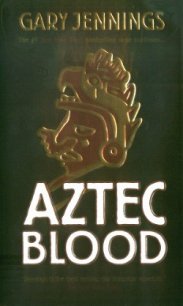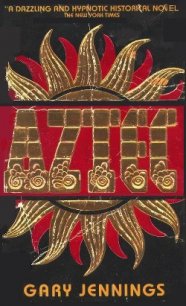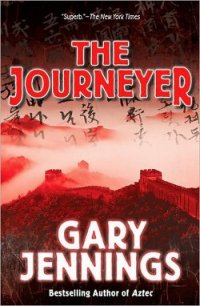Aztec Autumn - Jennings Gary (книга бесплатный формат .TXT) 📗
The other three old men more or less governed in concert: the Keeper of Religion, the Keeper of the Customs and the Leader of the Dances. The Yaki religion could rightly be called no religion at all, for they worship only their own ancestors, and of course anyone among them who dies becomes, that moment, an ancestor. Since the anniversary of any ancestor's death is a cause for ceremonies honoring it, hardly a night goes by in the Yaki lands without a ceremony, major or minor, depending on how important that person had been in life. The only "gods" recognized by the Yaki are their two longest-ago ancestors, scarcely real gods, but more like the Lord and Lady Pair whom we Azteca have always believed were the first begetters of our race. We do not actively worship ours, but the Yaki call theirs Old Man and Our Mother, and venerate them most deeply.
Also, the Yaki believe that their deserving dead go to a happy and eternal afterlife, like our Tonatiucan or Tlalocan, or the Christians' heaven. They call theirs The Land Beneath the Dawn, and rather foolishly insist that it is not immeasurably far away but nearby, just east of a notched mountain peak called Takala'im, which sits in the very middle of the Yaki lands. Where their undeserving dead go, the Yaki do not know and do not seem to care, for they can conceive of no place like our Mictlan or the Christians' hell.
They do, however, believe that they, the living, must be constantly on their guard against a whole host of invisible evil godlings or spirits called the chapayekam. Those are the pestiferous fomenters of illness, accidents, drought, flood, defeat in battle and every other misfortune that besets the Yaki race. So, while the Keeper of Religion sees to it that his people properly honor their ancestors, all the way back to Old Man and Our Mother, the Keeper of the Customs is charged with warding off the chapayekam. It is he who carves and colors the wooden masks intended to frighten them away, and he is continually trying to devise ever more hideous visages.
It follows that the Leader of the Dances is the busiest of the five yo'otui, for the communal dances are considered essential to the affairs of all the other four. The village work will not get properly done, the battles will not be won, the ancestors will not be sufficiently honored and the malignant spirits will not be adequately propitiated or dispelled unless the dances are done—and done just so. The Leader himself is too old to dance, and I found it somewhat comical that all the other men, who devoted their days to rough and bloody pursuits, should spend their every night in dancing solemnly, formally, even daintily, around celebratory bonfires. (It is hardly necessary to remark that the women never took part.)
The Leader dispensed to the dancers enough peyotl to give them unflagging energy, but not enough to fuddle or frenzy them so that they missed the precise steps and figures that had been prescribed through all the ages since the Ancient Times. The Leader hovered close to keep his hawk eye on the dancers, and to yank from among them any man who made a misstep or had the impudence to introduce a new one. They danced to what they called music, made by the men too old or crippled to dance. But since they lacked the variety of instruments invented by more civilized people, what they made was, to my ears, sheer noise. They blew on cane whistles, blew through water-filled gourds, rasped notched cane stalks together, shook wooden rattles and pounded on double-headed drums. (Though there was no paucity of animal hides, those drumheads were of human skin.) And the dancers themselves added to the noise, wearing anklets of cocoons, the dead insects inside clattering at every step.
For the dances honoring Old Man and Our Mother, or more recently departed ancestors, the men wore fanlike headdresses, but fashioned either of stiff cane strips or fluttering reeds, rather than feathers. For the dances intended to repel the wicked chapayekam, every man wore one of those gruesome carved and daubed masks, no two alike. For the dances danced to celebrate a battle victory—or to anticipate one—the men wore coyotin skins with the dead animals' toothy heads capping their own.
Then there was a dance done by one man alone, he the acknowledged best dancer in the village. This was the performance done to attract game for the hunters, in seasons when a drought or a disease had diminished the local population of wild animals. It truly was a graceful and exciting dance, and the more enjoyable because it was done without any "music." The man wore atop his head, secured by thongs, a buck deer's head—the handsomest procurable, with an impressive rack of antlers—and he was otherwise naked, except for bracelets and anklets of cocoons and he held in either hand an intricately carved wooden rattle. These provided the only accompanying noise as he various bounded like a startled buck, capered like a carefree fawn, shuffled bent over and wary, jerking his head about, like a hunter on the prowl. He might have to do this dance to exhaustion, many nights in a row, before some scout came to report that the game had returned to their usual habitats.
The Leader of the Dances confided to me, through G'nda Ke, that the game-attracting dance was much more efficacious in accomplishing its purpose when the dancer could dance around a sacrificial "doe." That would be a human female, tightly bound inside a doeskin. After she had been danced around for the ritual length of time, she would be butchered—just as was done to a real doe—dismembered, cooked and eaten by the men, they doing much slobbering and lip-smacking, so the wild game would sense their gratitude. Unfortunately, said the Leader, the Mayo men had not recently made any female-abducting raids on any alien village, so that part of the ceremony could not be demonstrated for my admiration. There were plenty of expendable Mayo females, he conceded, but they were too tough and stale and stringy to be lip-smackingly eaten. G'nda Ke managed to look affronted and sulky even at being slighted in that regard.
It mattered not to me that the Yaki men spent half their lives in dancing for reasons that I deemed absurd. What mattered was that the other half of their lives they dedicated to pure savagery, and that was what I wanted from them. When G'nda Ke translated my words to the five yo'otui, they very pleasantly surprised me by being more receptive to my message than some of the Raramuri chiefs had been.
"White men..." murmured one of the elders. "Yes, we have heard of white men. Our cousins, the To'ono O'otam, claimed to have had some of those wandering through their country. They even mentioned a black man."
Another grumbled, "What is the world coming to? Men should all be one color. Our color."
And another cautioned, "How can we know if the degenerate Desert People spoke truly? Had they been Yaki, now, they would have taken scalps to prove the existence of such beings."
And he was reminded by another, "We have never seen scalps of the evil chapayekam, but we know they exist. And they are of no color at all."
And the fifth, the elder in charge of warfare, said, "I believe it would do our yoem'sontaom good to fight someone besides their own relatives for a change. I vote that we lend them to this outlander."
"I concur," said the elder in charge of the village work. "If this outlander speaks truly about the rapacity of the white men, we may someday not have any relatives to fight, anyway."
"I agree," said the Leader of the Dances. "Let us keep here only the Deer Dancer and enough other dancers to satisfy Old Man and Our Mother."
"And to repulse the chapayekam," said the Keeper of the Customs.




